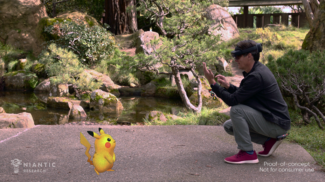Pokémon Go is in a class by itself with near-universal appeal and it will be a guiding light for AR development in the years to come.
Perhaps I’m a bit warped by my attachment to the creatures I started capturing on my Gameboy before the turn of the century. No matter where I went with my family, I was immersed in a world that lived inside my head as much as it did on that simple little monochrome screen.
My Squirtle evolved into Wartortle, who evolved into Blastoise, as he and I worked together to grow our bond and expand our collection of pocket monsters on a journey through the world together. I even had one of those magnifiers with built-in light so I could play at night with a bigger screen, consuming AA batteries as much as I did candy.
Decades later, Pokémon is still played by millions searching for monsters that roam unseen around the physical world. It is difficult to say exactly how many people play Pokémon Go each month as its developer, Niantic, remains a private company so its revenue and userbase can only be estimated by firms like Sensor Tower.
While the below chart is an estimate, the overall trend is likely true — Pokémon Go was a sensation in 2016 when it debuted, crashed the following year, and then steadily improved its revenue and game mechanics to grow overall. The evolution continued even through the COVID-19 pandemic when game changes made it easy to enjoy even while staying physically distant from other people.
The ugly truth of Pokémon Go in 2021 is the augmented reality portion of the game remains one of its worst features. There’s no reason to throw a Poké Ball and try to catch a Pikachu in AR except to make it harder to catch. We only hold our phones vertically like the feature requires when we’re taking a picture, and I’m not taking a picture when I’m catching a monster. Pokémon AR remains a terrible experience. For this to become great, our computers need to become glasses and they need to understand our environment to a degree we’ve still not seen in consumer hardware.
This is coming, it’s just unclear still how many years away it really is. Last year, Niantic acquired spatial mapping company 6D.ai and introduced a reality blending feature that more believably inserts Pokémon into the environment.
The feature is far from perfect.
In recent weeks, Niantic revealed a glimpse of the AR glasses it is developing based on a Qualcomm reference design.
And with Microsoft, Niantic recently teased full multiplayer Pokémon Go on HoloLens 2.
Facebook is working on AR glasses and Apple’s CEO Tim Cook was recently quoted as saying that AR was “critically important” to the future of the company while also stating person-to-person interactions could arguably be “better if we were able to augment our discussion with charts or other things.”
If by “charts” he means Pokémon stats and “other things” he means battles in a gigantic virtual stadium out in an open field? Then yes, Mr. Cook, you’re right. But given that the current state of AR is ruggedized hyper-expensive military tool or examining a 3D model with coworkers and hanging windows of 2D content in the room? I’m not sure that’s what Cook actually envisions. Either way, the future of my dreams is still far far away from realization.
The Pokémon universe will be absolute magic when it is finally realized with true head-worn AR and robust environmental understanding. The idea of leaving home on an adventure and befriending new creatures wherever you go is inviting to many groups of people in a way very few gaming franchises are. And the fact that Pokémon don’t die when they’re defeated in battle (they only faint) doesn’t hurt its appeal either. In my mind the franchise’s core tenets can be thought of as lasting friendship and harmless rivalry, and I can’t think of a layer I want added to reality that would be better than that.
That’s why — after all the technical milestones are met and you can release a Poké Ball from your fingertips and see it hit the ground in a cloud of dust where a giant creature bursts out — Pokémon Go should continue to be a guide shaping the development of AR over the long term.
In the year 2050 will people be catching Pokémon like I’ve described here? I think they will.








